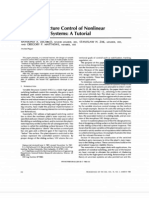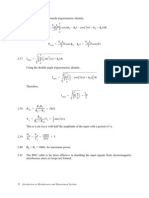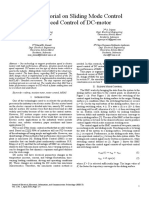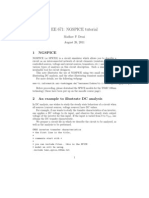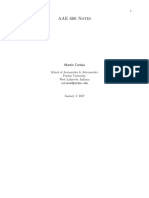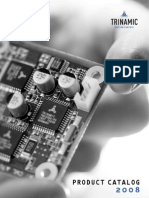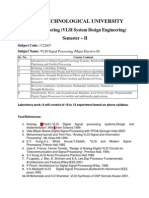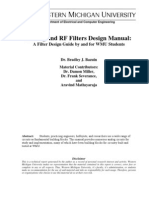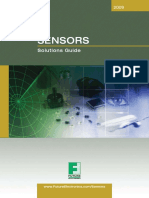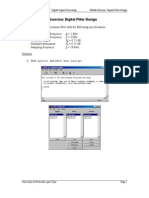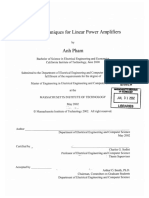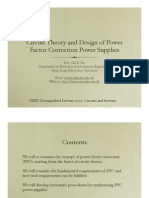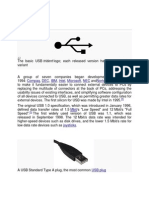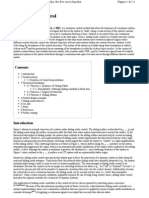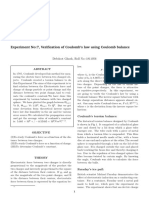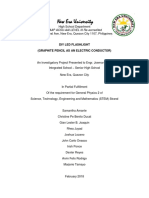Sliding mode control
From Wikipedia, the free encyclopedia
Jump to navigationJump to search
In control systems, sliding mode control (SMC) is a nonlinear control method
that alters the dynamics of a nonlinear system by applying
a discontinuous control signal (or more rigorously, a set-valued control signal)
that forces the system to "slide" along a cross-section of the system's normal
behavior. The state-feedback control law is not a continuous function of time.
Instead, it can switch from one continuous structure to another based on the
current position in the state space. Hence, sliding mode control is a variable
structure control method. The multiple control structures are designed so that
trajectories always move toward an adjacent region with a different control
structure, and so the ultimate trajectory will not exist entirely within one control
structure. Instead, it will slide along the boundaries of the control structures. The
motion of the system as it slides along these boundaries is called a sliding
mode[1] and the geometrical locus consisting of the boundaries is called
the sliding (hyper)surface. In the context of modern control theory, any variable
structure system, like a system under SMC, may be viewed as a special case of
a hybrid dynamical system as the system both flows through a continuous state
space but also moves through different discrete control modes.
Contents
1Introduction
2Control scheme
o 2.1Existence of closed-loop solutions
3Theoretical foundation
o 3.1Theorem 1: Existence of sliding mode
3.1.1Reachability: Attaining sliding manifold in finite time
3.1.1.1Explanation by comparison lemma
3.1.1.2Consequences for sliding mode control
o 3.2Theorem 2: Region of attraction
o 3.3Theorem 3: Sliding motion
4Control design examples
o 4.1Automated design solutions
5Sliding mode observer
6See also
7Notes
8References
9Further reading
Introduction[edit]
Figure 1: Phase plane trajectory of a system being stabilized by a sliding mode controller. After the
initial reaching phase, the system states "slides" along the line . The particular surface is chosen
�because it has desirable reduced-order dynamics when constrained to it. In this case, the surface
corresponds to the first-order LTI system , which has an exponentially stable origin.
Figure 1 shows an example trajectory of a system under sliding mode control.
The sliding surface is described by , and the sliding mode along the surface
commences after the finite time when system trajectories have reached the
surface. In the theoretical description of sliding modes, the system stays
confined to the sliding surface and need only be viewed as sliding along the
surface. However, real implementations of sliding mode control approximate this
theoretical behavior with a high-frequency and generally non-deterministic
switching control signal that causes the system to "chatter" in a tight
neighborhood of the sliding surface. Chattering can be reduced through the use
of deadbands or boundary layers around the sliding surface, or other
compensatory methods. Although the system is nonlinear in general, the
idealized (i.e., non-chattering) behavior of the system in Figure 1 when confined
to the surface is an LTI system with an exponentially stable origin.
Intuitively, sliding mode control uses practically infinite gain to force the
trajectories of a dynamic system to slide along the restricted sliding mode
subspace. Trajectories from this reduced-order sliding mode have desirable
properties (e.g., the system naturally slides along it until it comes to rest at a
desired equilibrium). The main strength of sliding mode control is its robustness.
Because the control can be as simple as a switching between two states (e.g.,
"on"/"off" or "forward"/"reverse"), it need not be precise and will not be sensitive
to parameter variations that enter into the control channel. Additionally, because
the control law is not a continuous function, the sliding mode can be reached
in finite time (i.e., better than asymptotic behavior). Under certain common
conditions, optimality requires the use of bang–bang control; hence, sliding
mode control describes the optimal controller for a broad set of dynamic
systems.
One application of sliding mode controller is the control of electric drives
operated by switching power converters.[2]: "Introduction" Because of the discontinuous
operating mode of those converters, a discontinuous sliding mode controller is a
natural implementation choice over continuous controllers that may need to be
applied by means of pulse-width modulation or a similar technique[nb 1] of applying
a continuous signal to an output that can only take discrete states. Sliding mode
control has many applications in robotics. In particular, this control algorithm has
been used for tracking control of unmanned surface vessels in simulated rough
seas with high degree of success.[3][4]
Sliding mode control must be applied with more care than other forms
of nonlinear control that have more moderate control action. In particular,
because actuators have delays and other imperfections, the hard sliding-mode-
control action can lead to chatter, energy loss, plant damage, and excitation of
unmodeled dynamics.[5]: 554–556 Continuous control design methods are not as
susceptible to these problems and can be made to mimic sliding-mode
controllers.[5]: 556–563
